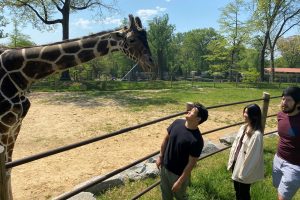
Giraffes are one of nature’s more interesting eaters, bringing to mind the Brachiosaurus scene in Jurassic Park. With their long necks, giraffes can reach leaves and branches most animals cannot, and due to their immense size, they spend up to 18 hours a day in the wild roaming and chewing, primarily on their favorite meal, the acacia tree.
Giraffes in the controlled environment of a zoo are fed on a more standard, regular schedule. Students in Johns Hopkins Engineering’s Multidisciplinary Design class are partnering with the Maryland Zoo to enhance the animals’ feeding experience.
A team comprising chemical and biomolecular engineering student Angel Garcia, mechanical engineering student Eric Guo, computer science students Melody Lee and Divya Ravindra, and Center for Leadership Education faculty mentor Nusaybah Abu-Mulaweh, worked with Joey Golden, curator of animal behavior programs at the Maryland Zoo, on the project. Golden reached out to a Whiting School of Engineering Multidisciplinary Design team to develop a prototype that encourages the animals to seek food in different places by emitting signals that attract the animals to various locations within their enclosure, and then providing food.

The team’s prototype
“The idea was to build a device that is an automated feeding system,” said Guo. “It would start with an auditory or visual signal, and that gives the giraffe a cue, so if it comes closer, the motion detector will sense it is in range and dispense some food.”
This would not replace the giraffes’ normal diet, but act as a supplement.
“This is extra food, like dessert,” said Golden. “The idea is they will learn to react to certain cues and the food is basically a reward.”
A key component of the team’s prototype is its small size and transportability. Feeding areas in the zoo are generally fixed, prompting giraffes to congregate in the same location when it’s time to munch. The team’s device can be moved easily to various locations and can be programmed to dispense food randomly and (at least to the animals) unpredictably, more closely mimicking conditions in the wild. What’s more, the device can be operated via keypad by zoo keepers, and can be easily dismantled and refilled.
The collaborative and broad nature of the project allowed room for a range of engineering knowledge, and the chance to work with animals was an intriguing element.
“We chose from a list of projects, and it sounded like the best one,” said Garcia.
Abu-Mulaweh said the partnership with the Maryland Zoo has been informative and fun.
“Visiting the zoo and having the students get a chance to engage with giraffes and learn from experts about giraffe behavior was not only motivating and enriching, but also crucial to being able to develop a solution routed in the needs of the giraffes and zoo keepers,” she said.